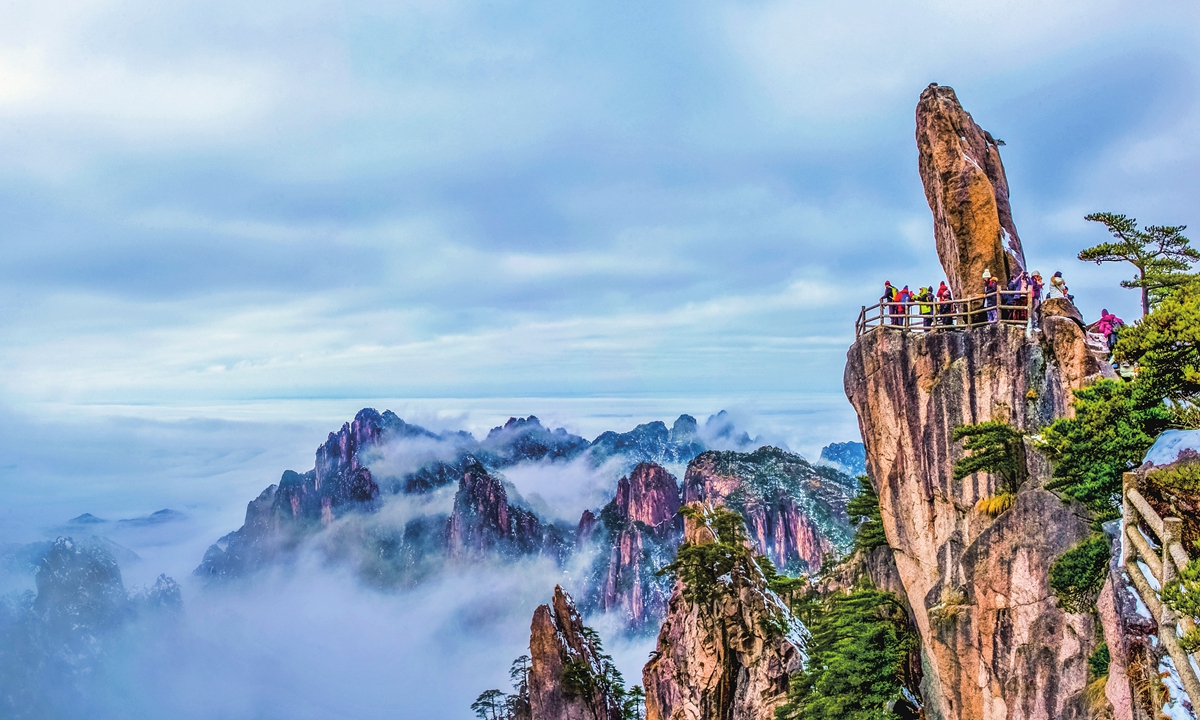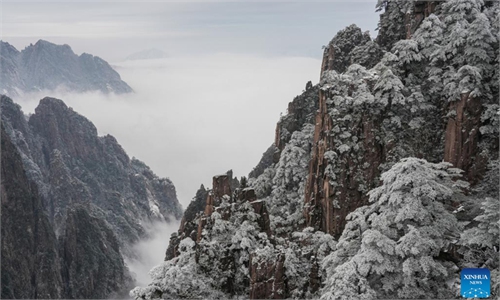ARTS / CULTURE & LEISURE
A place transformed: Revisiting Huangshan Mountain after 26 years

Overall view of Huangshan Mountain in East China's Anhui Province Photo: VCG
Huangshan Mountain, better known as the "Yellow Mountain" is always my favorite mountain in China. Since I went there for the first time in 1997, I had always longed to go back. Recently, I got a chance to revisit it and refresh my memory after 26 years.
Located in East China's Anhui Province, Huangshan Mountain is famous for its "five wonders," including wondrous pine trees, fantastic rock peaks, a sea of clouds, hot springs, and winter snow. It boasts rich flora and fauna resources, and numerous cultural relics such as the ancient steps, bridges and cliff inscriptions. A Chinese saying goes: "After returning from Huangshan Mountain, there is no need to visit other mountains." In 1982, Huangshan Mountain was listed among the national-level key scenic areas in China; and in 1990 it was inscribed on the World List of Cultural and Natural Heritage by UNESCO.
Breath-taking scenery
On the first morning, I took a cable car to go up from the front of the mountain, which enjoys a better view. I was thrilled by the breath-taking mountain view with steep cliffs, green and lush pine trees and deep valleys. My first stop was the well-known "Guest-greeting Pine," which was a must-see and a symbol of Huangshan Mountain. It is unique because of its graceful shape. It has a straight and upright body with its right "arm" extending further as if it wants to "shake hands" with guests, hence its name.
Soon I came across the most difficult part of our trip, the "Hundred-step Cloud Ladder." Built along the steep cliff, the path is only narrow enough for one person to pass at a time. It was raining hard when I arrived. Among a large crowd of tourists, I was inching ahead on the slippery stone steps in my rainy coat and with a heavy backpack. When I finally went past this place, I felt the hardest part was over.
Although the rain kept pouring with a strong wind in the afternoon, I didn't want to miss the opportunity to climb up to the Brightness Summit known as the best spot to watch the sunrise in the mountains. As the rain continued till the next morning, I realized that my dream of enjoying the sunrise there would remain what it was, a dream.
Despite my disappointment, I still got up very early the next morning. To my surprise, I had a chance to enjoy the serenity, breathe the fresh air, and take in the mountain view. I found I was enshrouded by misty clouds and the trees seemed to "be dyed in different layers of colors" with the nearest appearing green and the furthest grey, like in a wonderful Chinese ink painting. No wonder there is a Huangshan genre of Chinese landscape painting because the landscape really deserves a genre of its own. This was something I didn't get during my first busy trip and it was good enough to make up for my missed sunrise view.
During this journey, my great expectation was to visit the Xihai Grand Canyon, which was totally new to me. Developed in 2000, the 15-kilometer-long canyon was the deepest, steepest and most beautiful part of the mountain. I took a small train going straight down to the bottom, getting a good view of the crayon, its creeks, and the mountains in the clouds.
Although I was very tired, I didn't want to miss the Shixin Peak. This is an independent peak with cliffs around it. Still covered with clouds after the rain, the cliffs came and went away instantly, making it hard to capture their images in my camera. On my way downhill, the sun finally came out and in the golden afternoon sun, the whole mountain looked even more magnificent and unforgettable.
Impressive service facilities
Apart from the scenes, I was also deeply impressed by the service facilities along the way. At the entrance and exit of the mountain gate, deluxe tour buses took tourists up and down, to and from the cable car stations. Despite the zigzagging roads, I never lost my way since there were road signs everywhere, which were neatly made, clear and specific. In a mountain where most of the food supplies are carried by hand, food stalls and hotels were opened at every key site. Along the steep steps, I did not feel danger as handrails were installed on the sides of the paths and they divided the up and down lines of tourists orderly. At the foot of the mountain, there are a great many hotels, inns and restaurants for people to choose, making tourism a lot more comfortable.
Furthermore, I was more impressed by the sheer number of domestic tourists whom I did not find during my first trip 26 years ago. Many came with their families or in tourist groups. I think this showed more than anything the improved living standards of the people. Many of them could afford staying at luxurious hotels on the mountain, which could hardly have been imagined more than two decades ago.
Upon leaving Huangshan Mountain, I felt like this was not my last trip yet. I believe on my next trip, I will certainly find more changes to have taken place.


